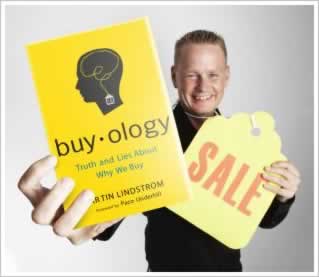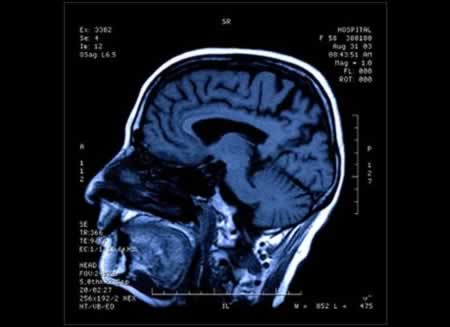
Probing the hidden hints of mind, in brand, in experience.
Martin Lindstrom is perhaps the most “branded” persona in branding. He’s young, unabashedly on a flame accelerant when it comes to fueling his ideas, research, and global traveling insights in exploring the ways that we are all influenced by enterprise / commerce development and communication methodologies.
I’ve connected with him, mostly online, here and there — and have been on personal email product boost links, as well as studying his Advertising Age overviews. There, in the pages of Ad Age, Martin Lindstrom has his own space. He’s not lacking for explorational zeal or personal branding enthusiasm. He’s living, literally, what he preaches about integrative thinking on the marketing front. He is — as a peson — a wholly layered marketing plan and brand. I’ve written about it — about him — before.
And, in perfect strategic synchrony, his opening expressions for pitching the conceptions, and the outcomes of the research, focus here — using his “buyological” analyses — the cultic branding and neuroscience of Christianity and its magnetism. Hoag Levins offers, “in an admittedly controversial undertaking, Martin Lindstrom’s consumer brain-scanning project has probed the “branding” secrets of Christianity. The findings were a major part of his recent Buyology Symposium in New York. There, he presented data correlations between 12 cult-like brands, including Harley Davidson and Ferrari, and the emotional drivers of the world’s largest religion.” A Dutch Ad group, YouAdDaily offers some insights in a group of responses, and commentaries, from Martin’s thinking in Buyology. Gijs de Swarte queries:

Your new book will shatter all common marketing wisdom? How?
You have measured the brain-activity of about 2000 people in response to all sorts of marketing communication?
Lindstrom: “That is right, neuromarketing is a young discipline. It uses high-tech brain-scanning techniques like Electroencephalography (EEG) and functional Magnetic Resonance Imaging (fMRI) that enable us to examine and analyze what really drives our behavior, our opinions, our preference for Apple or Microsoft, for Coca-Cola or Pepsi, this brand or that brand. The thing is, it is not about what you say or claim. There is no question and answer. It is about what your brain shows us. What was revealed by that was positively shocking to me.”
Your more pertinent findings?
Lindstrom: “Ok, the logo, the almighty logo. We have not only discovered that it is not as powerful as we thought it to be, in fact the more it is used, the less effective it is. For example, in Los Angeles we put up a gigantic billboard of a cowboy looking out over the dessert. We basically asked passers-by if they were smokers and if so if they felt like smoking a cigarette. Afterwards we repeated the same process only now we had the logo of the famous cigarette brand on the billboard. The activity in the nucleus accumbens; the area in the brain to look at when it comes to addiction, craving, things we perceive as fun, buying as well, was double when the logo was not there. We did many other related experiments as well. Time after time we saw the same phenomenon. We, for instance, did a test with the McDonald’s logo in a movie. We replaced it, in the same movie, with a shadow of a typical McDonald’s roof and that, according to the activity in the brain, really made people hungry.”
That proves?
Lindstrom: “The conclusion is obvious. We live in a world where every brand is pushing its logo; the bigger, the more places, the better. But indirect communication – the shadow of a roof that you might vaguely connect to the McDonald’s instead of the logo, is much more powerful. What happens is simple. Let’s say you walk into the office of your doctor because you have a headache. Outside you have seen a neon sign with an aspirin brand name. The brand name is on the door, on the cap the doctor is wearing, on the wall and on a display on his desk. Now your guard will go up. You’ll be alarmed and most likely annoyed. Your thoughts will probably be, piss off, I have a headache, give me something. And if he comes up with that specific brand you’ll be very sceptical. This is not just a funny story. This is how it really works and our research is there to prove it. A logo says, buy me, and, I am trying to persuade you, so be alarmed. No logo means, I don’t need to persuade you, I’m good, I’m sure of myself, you will like me anyway. When there is no logo, you are not guarding yourself and the natural human approach is, let’s see what it’s all about. Big brands have picked this up as well. There is no logo on the new iPod, United Colors of Benetton has removed the logo, Guinness beer doesn’t use the logo anymore, the lists goes on.”
Subliminal advertising targeted at your subconscious works best. Another ‘most shocking’ finding that illustrates your theory?
Lindstrom: “For the first time ever, we have scanned hundreds of peoples brains to test the effectiveness of product placement. Bluntly speaking, product placement is a waste of money. Personally I find it very annoying as well. Some time ago I went to the movie Sex And the City. There was a brand there every minute, seriously, a hundred or more. I should have been paid to watch that movie. But that aside, it is money thrown away. Your brand doesn’t benefit from it and here comes the kicker, it will often suffer. What happens is that the brand does not help the story to become more powerful. In ninety-nine percent of the case it is at least somewhat out of context and the brain asks, why do I have to look at that? It is disturbing, let me forget that. We also have strong indications that probably because of the initial negative response to product placement the mind erases the brand from its long term memory. Now the fact is that globally, in 2006, companies paid a total of 3.36 billion dollars to have their products placed in TV shows, movies and music videos. The Coca-Cola Company and the two other key sponsors of American Idol shelled out over twenty-six million dollars. I’d say, we’ve got a big thing here.”
Being a brand you have to make yourself known, famous — many would say. If you do so though, according to you, consumers will shut you out?
Lindstrom: “I looked at the tobacco industry, as we all know in many ways banned from advertising all over the world. Consequently they are years ahead of everybody. Look at an average Formula 1 race; red and white stripes all over the place, where there to use(d) be the name logo of a very well know(n) tobacco brand. Red and white uniforms everywhere. Recently in London in pubs and hotels I saw red and white tiles and furniture close to the vending machines. Let’s think about this; we are talking about a product you are not allowed to use inside a building, you can’t advertise for it and basically it is stated everywhere that when you use it, you will die. Smoking is fifteen percent up all over the world over the last three years. In other words they have figured something out.”
That is an iconic brand that can afford to leave part of the imagery out. People will dream that up themselves.
Lindstrom: “That is certainly true but we have also found that most successful brands very much work like a religion. And that can help any brand in finding means to express itself, to reach out to the consumer and connect to his or her subconscious mind.”
You have stated that before. It seems logical but how did you arrive at that insight?
Lindstrom: “I have spent years talking with brand fans, from obsessed Harley Davidson riders, to young Japanese Hello Kitty admirers (one of whom, incidentally, owns more than 12 000 pieces of Hello Kitty merchandise), to devoted Irish Guinness drinkers. Time after time I have been struck by the apparent parallels between the power of religion and brands over their followers. For Buyology we have recruited hundreds of research subjects / volunteers from all over the world who count themselves as Christians. We wanted to examine whether the same brain activation evident in the devout Christian’s brain, when exposed to faith-related triggers, was also evident in the brains of fans of emotionally powerful brands like Apple, Harley Davidson and Guinness when they were exposed to the iconography of their brand preferences. My suspicions were confirmed. It turned out that, when exposed to faith-based triggers, the Christian volunteers‚ brains evinced activity in the same region of the brain as that activated in the brains of brand fans, exposed to brand stimuli. In contrast, brands that don’t fall among the rarified group of highly emotional brands revealed almost the opposite brain response. Brands like BP and KFC provoked less brain activity and engaged fewer brain regions than brands with fan bases.”
This knowledge can be used to build a brand without conventional advertising?
Lindstrom: “Yes. What do you need to keep in mind? Most religions have a strong enemy-image that tells you what you are and what you are not. Religions have rituals and symbolic language. Religions have evangelists; a group of strong believers who spread the word. Religions are based on a sense of belonging to a community and what I call ‘grandiose thinking’. I’m talking about the ability to think big, like Google Earth, like Dubai – building the highest building in the world, like Heineken with the tagline, ‘Serving the planet’. All the most powerful brands in the world have these and some other pseudo religious elements, think Coca-Cola and Peps, Apple and Microsoft, Virgin and British Airways. And – and there lies some of the solutions for marketers – these are all things you can build up without using conventional marketing communication techniques.”
One or two ethical questions. Targeting the subconscious mind, doing what according to you Marlboro is doing – probably doesn’t sound very sympathetic to many peoples ears.
Lindstrom: “First of all, you can not program consumers to do things. I’m a consumer too by the way, and my view is that you can use a hammer to hang a beautiful picture on the wall and you can use it to destroy people, like the tobacco industry does. My standpoint is, I’m writing this to start the debate. There are hardly any rules around in this new field. I think here should be (the beginning), and informing the public about this is a step in the right direction. This exists, companies are using it now — and more and more will. Let’s get it out in the open. Let companies use it in a good way and not be afraid to tell us about it, because they have nothing to hide. If we are getting there we are on the right track in my view.”
Neuromarketing is indeed very new. Every expert would also say that we know virtually nothing about the brain. So – just about anything anybody says about how it reacts to marketing communication can and will be disputed.
Lindstrom: “I totally agree. I always say that you can compare what we know of the brain today to what Christopher Columbus understood of the globe in the fifteenth century. When he discovered America that was an enormous leap forward. If you look back though you can see how much there was to be discovered afterwards. I don’t want to compare Buyology to what Columbus did but I’m convinced it is the beginning of tremendous change.”
In the range of my experience, the conceptions of how to reach into the mind of the consumer, over time, have run the gamut. These have moved from Zaltman’s “marketing metaphoria”, the concept of the exploration of deep metaphors as a revealing tool of the minds of consumers — to exploring “lovemarks”, P&G epiphanic shelves studies to barging into people’s homes and living with them, going through their closets to learn more about what they’re thinking about. Zaltman’s methods are patented — and the framing of his research is similarly connected to “buyology”; in that, in some relevance to Lindstrom’s propositions: that in sharing imagery that is “held” by the consumer, there’s a kind of deeper sanctification of it. Of course, these theories — and others out there, are far larger and more complex that these quick assessments.
Lindstrom’s methods are supposing that, as he intones, it’s not something that is necessarily “wrenching” commitment from consumer relationships, merely going deeper into the heart of how people connect, relate, and hold content and conceptions for brand — and their relationships to them. And, to his added developments, how they relate to the “good side”, and not the bad side — they commit, just in the alignments of religious affiliation, with “their side”. It’s good. Not “evil”, so to speak.
Brand is, where possible, about:
1. Longing and belonging — to hold something (anything) I need to be part of it, connected with it. Holding is like that — being held is that touch that warms the connection between product, idea, ideology and service — to person.
2. Storytelling — it is about that; the basic coating of identity is the skin — it’s what inside the skin that is palpable — and memorable.
3. Reflectivity — business propositions work two ways — towards the consumer and away from the relationship; that is — if I hold the brand, the essence of communication from the business proposal, then I will share it.
4. Ritualization of experience — what is the connection, the engagement that the user holds to be true? Like the experience of religious integration — the prayerful mediation to a higher power, for example, there is a rite that connects.
But for me, it is about what is loved, and what is not.

What about you, where’s your head at? I’m curious about your take — in your perspective, your history, in testing / consumer relationships, what’s the meaning here? I’d suggest: another story, brand spirit
TSG | Queen Anne Hill, Seattle.
Added references:
Lindstrom:
A contrarian positioning, from another marketing strategist.
Lindstrom / Community: blogs
Lindstrom / Dutch interview: Gijs de Swarte
Google overviews
Books:
Zaltman, G. and L. Zaltman, Marketing Metaphoria: What Deep Metaphors Reveal about the Minds of Consumers (2008).
Zaltman, Gerald. How Customers Think: Essential Insights into the Mind of the Markets. Boston: Harvard Business School Press (2003).
Braun-Latour, Kathryn A., and Gerald Zaltman. “Memory Change: An Intimate Measure of Persuasion.” Journal of Advertising Research (March 2006): 57-72.
Edwards, Jim. “Spotlight Flashback: Why Buy? Researchers seek An Answer” Brandweek (September 10, 2007).
“The premise of the book is that eighty-five percent of what we are doing when it comes to buying decisions and our relationships to brands is directed by our subconscious. And if that is the case we have a big problem in the world of marketing and advertising because everything we do is directed to our conscious mind. We all have learned that subliminal advertising does not work. The classical example is when you show an image of a bottle of Coca- Cola during a movie, for a fraction of a second; so fast you are not able to see it but your subconscious will take note of it, the concession stand will probably run out of soft-drinks before the movie ends. It is supposed to be a fable. Well I don’t (k)no(w) about this specific technique but we have learned that not only does subliminal advertising work, it is in fact the most powerful way to build a brand.”